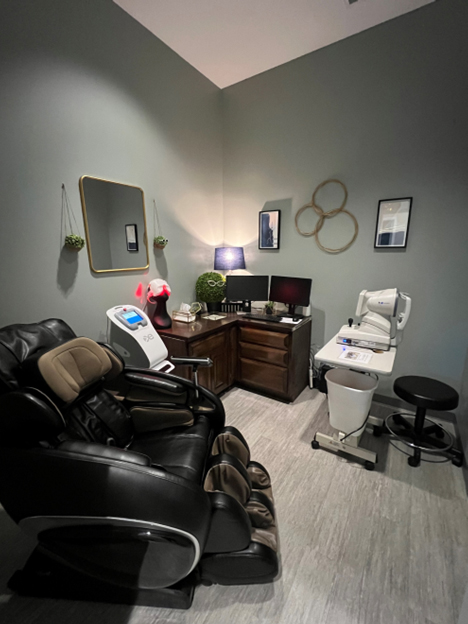
Dr. Turrisi’s in-office dry eye treatment spa, which utilizes low-level light therapy, among other technology, to provide patients with modern treatment solutions for dry eye disease.
By Kirsten Turrisi, OD
March 8, 2023
Keeping up with the times, so patients feel your office aligns with other businesses they visit, is not easy. It requires a technology investment, along with paying attention to how you and your staff interact with patients.
From start to finish, you need to show your patients that you have it all. We like to think that we stay up to date with all the latest technology in our field, but for patients, it is not just about the technology, although that does give your office the wow factor.
It’s about convenience. In the 21st century, we have everything accessible at the touch of a finger, so your office should be able provide the same convenience with the latest technology.
Here are a few ways we are investing in our office to give patients an experience that keeps up with the best attributes that other businesses and practices have to offer.
Effective Communication with Us that Requires Little-to-No Effort
Our office uses an automated all-in-one platform for phones, scheduling, reminders, texting, faxing, and more, that is integrated with our EHR system.
There are many recall systems to choose from. The one we went with was Weave. It was tiresome to have a dedicated person calling to remind patients of their appointments. Eliminating the need for someone to manually call patients was our main goal initially in implementing this technology, but we now use it for many other functions. We even fax directly from the system with files already in the patient’s chart in our EHR, which speeds up patient-doctor or doctor-doctor correspondence.
Editor’s Note: There are many other recall systems to choose from, including Demandforce, Solutionreach and Simplifeye, among other recall/patient communication technologies.
We can text or e-mail patients about their appointments, and we can specify what we want the reminder text message to say. While there are some patients who would prefer a call, most patients would rather avoid a phone call if they can.
This recall technology costs us an average of $6,500 annually. That may sound high, but it is significantly cheaper than hiring a dedicated employee to notify patients of their appointments, their contact lens or glasses orders and answer online questions. Logistically, getting this technology up and running was simple. The most difficult part was trying to train employees to remember to login to their individual accounts on their computer like they would when they sign into the EHR system.
Other Articles to Explore
Patients appreciate the 21st century text reminders instead of a phone call. They can look at our messages at their convenience without stopping whatever they are doing. Patients can even directly respond and the message from them will pop up on our employees’ computers with the patient’s name, so we can directly communicate with them. Patients have been receptive to the change and appreciate the ease of communication.
This kind of recall technology makes life easier for staff, too. We can mark a glasses/contact lens order as ready to dispense and the technology will notify the patient for us. For those patients who prefer a phone call, we note this preference in their chart so they will continue to get manual phone calls instead of the automated message.
On our website, we also integrated a widget from our recall technology so that when a patient is on our site, they can click on the widget and speak with an employee in real time, enabling us to offer online chat. This is more modern than having a patient e-mail you through your website and having to wait hours, or even days, to get a response. Patients have been responsive to this widget on our website and love the quick responses from our staff.
Enable Completion of Documents Ahead of Time Online
We added online paperwork to our website to streamline our patients’ experience. The paperwork is integrated with our EHR system so our technicians do not have to waste time copying over information. The paperwork was included with our EHR, Crystal Practice Management, but we spent an additional $150-$200 for customization of the paperwork and to have it be mobile friendly.
Editor’s Note: There are many other electronic health record technologies to choose from, including Eyefinity EHR, RevolutionEHR and Compulink Advantage, among many others.
When patients are scheduled for an appointment, a staff member sends them a link to the online paperwork directly to their e-mail. We even ask established patients to do paperwork as it pre-populates with information from their last exam, so they only need to update any changes. This helps save significant time during their exams and gives our office the modern feel patients have come to expect.
In addition, our office uses iPads for HIPAA signatures to minimize paper waste and decrease employee time scanning in hard copies into patients’ charts. The app on the iPad for our EHR system was only $20. With the app, we can also add any additional paperwork we want patients to sign such as waivers, forms to choose eye screening via technology in lieu of dilation and anything else we may require. Patients love the modern feel of signing on an iPad!
Newest Ways to Treat Old Problems
We know that for our dry eye patients, taking eye drops can be tedious at best. Our office offers one of the newest treatments for dry eye therapy: low-level light therapy (LLLT). The system we chose to deliver this treatment is the Equinox LLLT by Marco. We purchased the CA-800 corneal topographer by Topcon Healthcare to help us determine the patients who would benefit from this type of dry eye treatment.
Editor’s Note: There are many technologies available to support the diagnosis of dry eye disease, including Visionix VX 120+ Dry Eye and ZEISS Atlas 9000, among other systems.
The cost for setting up our treatment room was negligible except for the massage chair, which we got for free. We were fortunate in that I had a massage chair in my family that was no longer being used, which I was able to add to our treatment room to give it a spa-like feel. While the massage chair is not required, it does help provide the wow factor.
The CA-800 does meibography, as well as tear testing (including blink rate, TBUT, OPI and IPI). Although there is not a direct CPT code for meibography, it can be billed as external photos with a diagnosis of meibomian gland dysfunction. We typically charge patients their specialist co-pay for an office visit and charge $55 per treatment session.
Our cost per treatment is around $13 and we make an average of $100 – $150 per treatment. Most patients will do 3-4 treatments with a maintenance treatment once every six months or as needed. In the first three months of offering LLLT, we have already earned around $18,000.
As word continues to spread, and with our doctors educating their patients during their exams, the advertising we do through our website, along with our social media pages, we anticipate continuing to grow our profits from the LLLT to generate $60,000-$70,000 per year.
Provide More Lens Options In-House
Optical sales are about half of most practices’ generated revenue, so how do you keep patients in your office instead of going to your competitors to purchase eyewear? Again, by offering what others cannot, a modern 21st century experience with all the latest technology that the industry has to offer.
To advance our office into the 21st century, we purchased the newest Santinelli edger. With this purchase, we are now able to offer Chemistrie Clip-ons, as well as many other lens options that we used to have outside labs do, including drilled rimless mounting. We wanted to be able to decrease some of our lab charges while, at the same time, offer more to our patients. We utilize Chemistrie, not just as sunglasses, but as an alternative to progressives for the non-adapt patient. We can do plus power clip-ons in a variety of powers to accommodate all distances. This has also been a large help to progressive wearers who struggle on the computer.
Editor’s Note: There are many lens edgers to choose from. Other options include those from Visionix, Essilor and Coburn Technologies, among others. Similarly, there are many polarized clip-on sunglasses to choose from.
Installation of our new edger took the better part of a day and another day to train our opticians on the equipment. In that time, we did get backed up with lens orders, but it was worth it! It took a few days for everyone to become comfortable using the new edger, and it took even longer to become proficient with the Chemistrie drilling and mounting.
The Santinelli edger cost around $75,000, which included a lens blocker. While a generic edger costs significantly less, it also does substantially less. The old motto stands, you get what you pay for. While it was more of an upfront cost, we are saving money on the back end by doing things we used to pay an outside lab to do.
On average, if we sell a mere six drilled rimless frames a month, it would normally cost us $35 for a lab charge to cut the lens with the mounting. That is $2,520 per year that we would be paying to an outside lab. Additionally, any other lenses that we would need to send to an outside lab for edging would cost us $12 per job. While it might seem nominal, it starts to add up.
The Chemistrie set was included in the purchase of the edger. We charge a flat $150 per clip on. That includes the magnets for the lenses, the metal bridges and the lenses themselves. The cost per clip on is $12-$16, which nets a profit of ~$135, and we expect that many patients will start to realize that one singular clip is not enough.
In the first two months of having the Chemistrie option for patients, we have already sold over 15 clips, which generated around $2,055 in profits. We anticipate this number to continue to grow as word gets around about what our office offers where others fall short. If we continue to sell an average of seven clips per month, that is ~$144,000 annually in profit.
Keeping up in the 21st century requires a proactive approach, if you stay idle too long, you’ll stay in the past. Never stop adapting and improving your practice to provide your patients with the best care and best experience you can offer.
 Kirsten Turrisi, OD, is the co-owner of 20/20 Vision Center in Goldsboro and Greenville, N.C. To contact her: 2020visionNC@gmail.com
Kirsten Turrisi, OD, is the co-owner of 20/20 Vision Center in Goldsboro and Greenville, N.C. To contact her: 2020visionNC@gmail.com

























